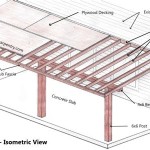How to Build a Round Brick Patio
A round brick patio adds a unique and charming touch to any backyard. It can serve as a gathering space for friends and family, a relaxing spot for enjoying a quiet afternoon, or a stunning focal point in your outdoor design. Constructing a round brick patio requires careful planning and execution, but it's a project that can achieve rewarding results with the right approach. This article will guide you through the steps involved in building a beautiful and functional round brick patio.
1. Planning and Preparation
The initial phase of any construction project is crucial. You'll need to gather information on the necessary materials, determine the ideal location, and outline the steps for creating your round brick patio.
a) Location and Size
Choose a location that is level, well-drained, and free from obstructions. Consider the surrounding landscape and how the patio will integrate into the overall design. The size of your patio depends on your needs and available space. A smaller patio, with a diameter of 8-10 feet, might be ideal for a cozy seating area. A larger patio, with a diameter of 12-15 feet or more, can accommodate a larger group or multiple seating areas.
b) Materials
You'll need several essential materials for your round brick patio. Here's a typical list:
*Bricks:
Choose durable and weather-resistant bricks for your patio. Consider size, color, and texture to match your desired aesthetic. *Sand:
Use sand as a base layer to level the patio and create a smooth surface for the bricks. *Mortar:
Use mortar to bond the bricks together. Choose a mortar mix that is appropriate for outdoor use and the climate you live in. *Edging Materials:
This could include landscaping timbers, stone, or even concrete to create a defined edge for your patio. * **Tools: * Measuring tape * String line * Level * Hammer * Trowel * Tape measure * Wheelbarrowc) Design and Layout
Determine the desired size and shape of your round patio. You can use a string line and stakes to create a circular outline on your chosen location. It's helpful to visualize the layout and consider factors like access points, seating arrangements, and other outdoor features you might want to incorporate.
2. Excavation and Base Preparation
The foundation of any structure is paramount, especially for an outdoor space like a patio. Proper excavation and base preparation ensure that your patio remains stable and level over time.
a) Excavation
Clear the chosen location of any vegetation and debris. Use a shovel or excavator to remove the topsoil to a depth of 6-8 inches. This depth allows for sufficient space for the sand base and the brick layer.
b) Compacting the Base
After excavating, level the area using a level and a shovel. Compact the soil firmly to prevent settlement. You can use a compactor or a hand tamper for this step. This ensures that the foundation is solid and can withstand the weight of the bricks and the traffic it will receive.
c) Sand Layer
Once the base is compacted, spread a 4-6 inch layer of sand evenly over the entire area. Use a level to ensure that the sand is leveled properly. This layer helps create a smooth surface for the bricks and provides a stable foundation. Dampen the sand with water to help it compact before laying the bricks.
3. Laying the Bricks
With the base ready, you can begin laying the bricks. Accuracy and attention to detail are crucial during this stage.
a) Creating Mortar Beds
Use a trowel to spread a layer of mortar across the sand base. Ensure that the mortar bed is even and smooth. The thickness of the mortar bed will depend on the size of the bricks you are using, so consult the manufacturer's instructions for recommended thickness. This step ensures that the bricks are properly supported and bonded together.
b) Laying the First Row of Bricks
The first row of bricks is critical for establishing a level and symmetrical circle. Begin by laying the first brick in the center of the circle. Use a string line to guide you and ensure that the brick is centered. Lay the remaining bricks in the first row, keeping them equidistant from the center.
c) Laying Subsequent Rows
As you lay subsequent rows, ensure that the bricks are properly aligned and level with each other. You can use a level to check the bricks as you go. Use a brick hammer to tap the bricks into place gently, making sure that they are flush with each other. This helps to create a smooth and consistent appearance for the patio.
d) Spacing and Mortar Joints
Maintain consistent spacing between the bricks, usually around 1/4 inch. Use a spacer to help you achieve this. The mortar joints between the brick should be filled neatly and evenly. These joints provide strength and stability to the patio.
e) Cutting Bricks
You may need to cut bricks to fit the circle perfectly. You can use a brick saw or a grinder to make precise cuts. Be sure to wear safety goggles and gloves when cutting bricks.
4. Finishing Touches
Once the brickwork is completed, focus on creating a seamless and visually appealing finish for your patio.
a) Grouting
When the mortar is dry, grout the joints between the bricks to create a durable and water-resistant finish. Use a rubber trowel to press the grout into the joints, and then clean off any excess grout with a damp sponge. This step helps seal the patio and improves its overall appearance.
b) Sealing
Sealing the bricks is optional, but it can help protect the patio from staining and weathering. Apply a penetrating sealant that will protect the bricks, but will not change the look or feel of them. Let the sealant dry completely before using the patio.
c) Edging Installation
Install your chosen edging material around the perimeter of the patio. This creates a defined edge and prevents the bricks from shifting. The edging can be installed using concrete, landscaping timbers, or stone, depending on your preferences and budget.
d) Landscaping and Decoration
Once the patio is finished, you can add landscaping elements to enhance its visual appeal. Consider adding plants, flowers, or decorative stones around the patio perimeter, and create a welcoming and inviting space.

How To Build A Round Paver Patio

How To Build A Round Paver Patio

How To Lay A Circular Patio Hardscape Basics Western Interlock

How To Lay A Circular Patio Hardscape Basics Western Interlock

How To Lay A Circular Patio Hardscape Basics Western Interlock

Think Outside The Square Curved And Round Patios Walkways Pine Hall Brick

How To Build Round Paver Brick Patio Lay Two Color Clinker Stones Individual Great Terrace Diy

How To Lay A Circular Patio Hardscape Basics Western Interlock

Inside Out How A Nationally Known Interior Stylist And Her Dedicated Diy Er Husband Took It Outside To Add Circular Patio In Their Backyard Pine Hall Brick

How To Build A Circular Patio And Retaining Wall Diy








